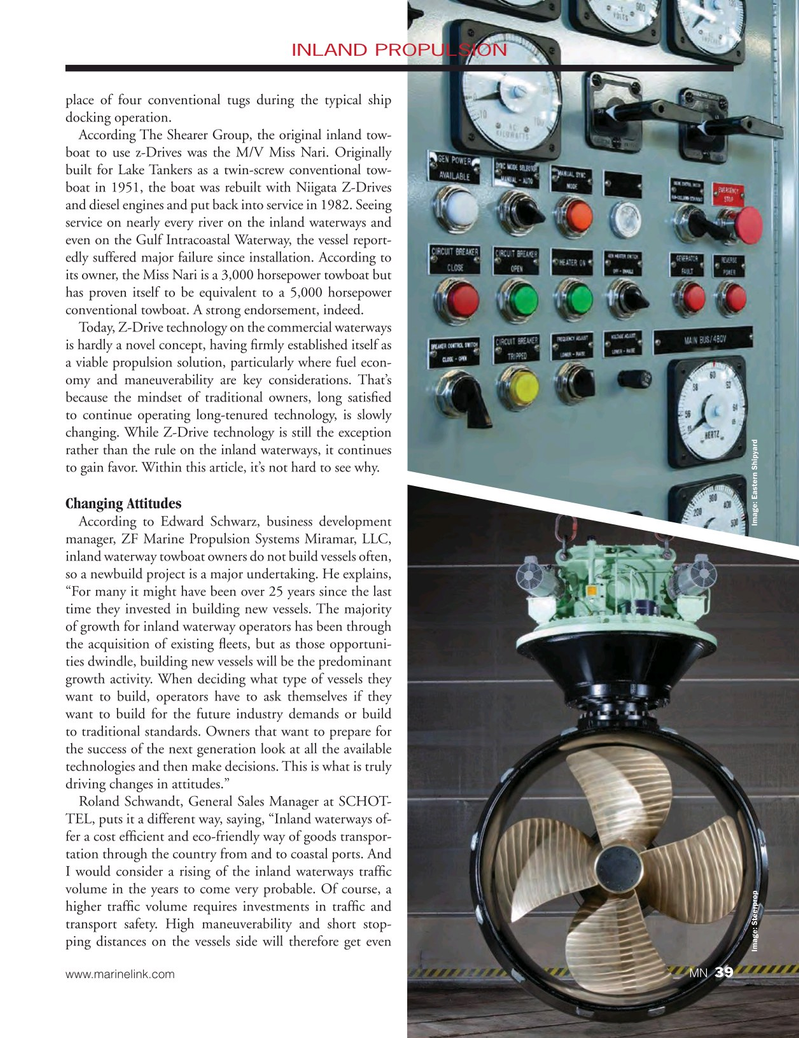
Page 39: of Marine News Magazine (January 2016)
Read this page in Pdf, Flash or Html5 edition of January 2016 Marine News Magazine
INLAND PROPULSION place of four conventional tugs during the typical ship docking operation.
According The Shearer Group, the original inland tow- boat to use z-Drives was the M/V Miss Nari. Originally built for Lake Tankers as a twin-screw conventional tow- boat in 1951, the boat was rebuilt with Niigata Z-Drives and diesel engines and put back into service in 1982. Seeing service on nearly every river on the inland waterways and even on the Gulf Intracoastal Waterway, the vessel report- edly suffered major failure since installation. According to its owner, the Miss Nari is a 3,000 horsepower towboat but has proven itself to be equivalent to a 5,000 horsepower conventional towboat. A strong endorsement, indeed.
Today, Z-Drive technology on the commercial waterways is hardly a novel concept, having ? rmly established itself as a viable propulsion solution, particularly where fuel econ- omy and maneuverability are key considerations. That’s because the mindset of traditional owners, long satis? ed to continue operating long-tenured technology, is slowly changing. While Z-Drive technology is still the exception rather than the rule on the inland waterways, it continues to gain favor. Within this article, it’s not hard to see why.
Changing Attitudes
According to Edward Schwarz, business development manager, ZF Marine Propulsion Systems Miramar, LLC, inland waterway towboat owners do not build vessels often, so a newbuild project is a major undertaking. He explains, “For many it might have been over 25 years since the last time they invested in building new vessels. The majority of growth for inland waterway operators has been through the acquisition of existing ? eets, but as those opportuni- ties dwindle, building new vessels will be the predominant growth activity. When deciding what type of vessels they want to build, operators have to ask themselves if they want to build for the future industry demands or build to traditional standards. Owners that want to prepare for the success of the next generation look at all the available technologies and then make decisions. This is what is truly driving changes in attitudes.”
Roland Schwandt, General Sales Manager at SCHOT-
TEL, puts it a different way, saying, “Inland waterways of- fer a cost ef? cient and eco-friendly way of goods transpor- tation through the country from and to coastal ports. And
I would consider a rising of the inland waterways traf? c volume in the years to come very probable. Of course, a higher traf? c volume requires investments in traf? c and transport safety. High maneuverability and short stop- ping distances on the vessels side will therefore get even
Image: Steerprop Image: Eastern Shipyard 39 www.marinelink.com MN
MN Jan16 Layout 32-49.indd 39 1/6/2016 2:39:15 PM

 38
38

 40
40
